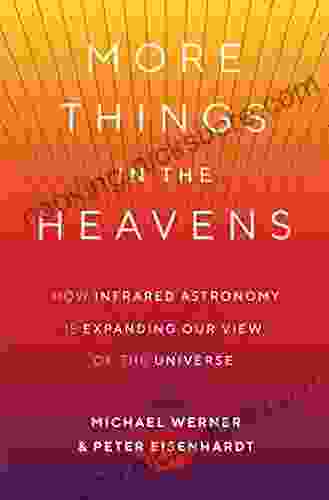More Things in the Heavens: Uncovering the Secrets of the Cosmos

The Vastness of the Universe
The universe is vast beyond our comprehension. It contains billions of galaxies, each composed of billions of stars. Our own galaxy, the Milky Way, is just one of many in the observable universe.
4.6 out of 5
| Language | : | English |
| File size | : | 76283 KB |
| Text-to-Speech | : | Enabled |
| Screen Reader | : | Supported |
| Enhanced typesetting | : | Enabled |
| Word Wise | : | Enabled |
| Print length | : | 298 pages |
The size of the universe is estimated to be around 93 billion light-years across. This means that it would take light 93 billion years to travel from one end of the universe to the other.
The universe is constantly expanding, and the galaxies within it are moving away from each other. This expansion is accelerating, which means that the universe is becoming increasingly vast.
The Birth and Death of Stars
Stars are born in giant clouds of gas and dust called nebulae. When a nebula collapses under its own gravity, it begins to rotate. As it rotates, it flattens out into a disk. The center of the disk becomes a protostar, which is a hot, dense ball of gas.
As the protostar continues to collapse, it heats up and begins to fuse hydrogen atoms into helium atoms. This process releases energy, which causes the star to shine. The star will continue to burn hydrogen until it runs out. When this happens, the star will begin to die.
The death of a star depends on its mass. Small stars will simply fade away into white dwarfs. Medium-sized stars will become red giants. And massive stars will explode in supernovae.
Planets and Exoplanets
Planets are objects that orbit stars. They are made of rock, gas, or ice. The eight planets in our solar system are Mercury, Venus, Earth, Mars, Jupiter, Saturn, Uranus, and Neptune.
Astronomers have discovered thousands of exoplanets, which are planets that orbit stars outside of our solar system. Exoplanets come in a variety of sizes and compositions. Some exoplanets are rocky, like Earth. Others are gaseous, like Jupiter. And some exoplanets are even made of ice.
Black Holes
Black holes are regions of spacetime where gravity is so strong that nothing, not even light, can escape. Black holes are formed when massive stars collapse at the end of their lives.
Black holes are invisible, but they can be detected by their gravitational effects. Astronomers can observe the way that black holes distort the light from nearby stars.
Dark Matter and Dark Energy
Dark matter and dark energy are two mysterious substances that make up most of the universe. Dark matter is a type of matter that does not interact with light or other matter. Dark energy is a force that is causing the universe to expand at an accelerating rate.
Astronomers are still learning about dark matter and dark energy. However, these substances are essential to understanding the universe's evolution.
The Future of Astronomy
The future of astronomy is bright. With new telescopes and advanced research techniques, astronomers are poised to make even more groundbreaking discoveries about the cosmos.
In the coming years, astronomers will learn more about the nature of dark matter and dark energy. They will also discover new exoplanets and explore the atmospheres of planets in other solar systems.
The universe is a vast and mysterious place. But through the work of astronomers, we are slowly unlocking its secrets. The future of astronomy is full of possibilities, and we can't wait to see what discoveries lie ahead.
4.6 out of 5
| Language | : | English |
| File size | : | 76283 KB |
| Text-to-Speech | : | Enabled |
| Screen Reader | : | Supported |
| Enhanced typesetting | : | Enabled |
| Word Wise | : | Enabled |
| Print length | : | 298 pages |
Do you want to contribute by writing guest posts on this blog?
Please contact us and send us a resume of previous articles that you have written.
 Fiction
Fiction Non Fiction
Non Fiction Romance
Romance Mystery
Mystery Thriller
Thriller SciFi
SciFi Fantasy
Fantasy Horror
Horror Biography
Biography Selfhelp
Selfhelp Business
Business History
History Classics
Classics Poetry
Poetry Childrens
Childrens Young Adult
Young Adult Educational
Educational Cooking
Cooking Travel
Travel Lifestyle
Lifestyle Spirituality
Spirituality Health
Health Fitness
Fitness Technology
Technology Science
Science Arts
Arts Crafts
Crafts DIY
DIY Gardening
Gardening Petcare
Petcare Jenna Miscavige Hill
Jenna Miscavige Hill Thomas Watson
Thomas Watson Roland Martin
Roland Martin Jonathan Clements
Jonathan Clements Simon Garfield
Simon Garfield Hayley Campbell
Hayley Campbell Luigi Gabriele Conti
Luigi Gabriele Conti Robert B Yonaitis
Robert B Yonaitis Ola Ola
Ola Ola Steve Sheinkin
Steve Sheinkin Peter Scazzero
Peter Scazzero Nathaniel Philbrick
Nathaniel Philbrick Roberto Pedreira
Roberto Pedreira Dorothy Pang
Dorothy Pang Kathleen Dean Moore
Kathleen Dean Moore Course Hero
Course Hero Ken Blanchard
Ken Blanchard Daniel Humm
Daniel Humm Christopher Sommer
Christopher Sommer Jonathan Cummings
Jonathan Cummings George Christian Pappas
George Christian Pappas Michael Hermann
Michael Hermann Paul Rooyackers
Paul Rooyackers Garcilaso De La Vega
Garcilaso De La Vega Becky Lomax
Becky Lomax Jen Calonita
Jen Calonita Jim Apfelbaum
Jim Apfelbaum Ronald D Davis
Ronald D Davis Rita Jablonski
Rita Jablonski Gabby Rivera
Gabby Rivera Stacey Little
Stacey Little Jay Greeson
Jay Greeson Margaret Thorsborne
Margaret Thorsborne John Bantin
John Bantin Laurie Seale
Laurie Seale Terence Callery
Terence Callery Ed Willes
Ed Willes Andrea Curtis
Andrea Curtis Leslie Vedder
Leslie Vedder Kelly Oliver
Kelly Oliver Daniel Shiffman
Daniel Shiffman Gemma Rogers
Gemma Rogers Nancy B Rapoport
Nancy B Rapoport Stuart L Kaplan M D
Stuart L Kaplan M D Melissa Caughey
Melissa Caughey Ryan Pellett
Ryan Pellett Charlotte Elkins
Charlotte Elkins Rachel Meltzer Warren
Rachel Meltzer Warren Robyn Sheldon
Robyn Sheldon Cathal Armstrong
Cathal Armstrong Dani Jacobs
Dani Jacobs Tamara Ireland Stone
Tamara Ireland Stone Cliff Wilson
Cliff Wilson James Dodson
James Dodson Mason Deaver
Mason Deaver George Hospodar
George Hospodar Peter David
Peter David J E Lendon
J E Lendon Nancy Mcwilliams
Nancy Mcwilliams Steve Anthony Tallon
Steve Anthony Tallon Dot Edu
Dot Edu Laird Hamilton
Laird Hamilton Steve Caplin
Steve Caplin Kristin Briney
Kristin Briney Mike Davenport
Mike Davenport Christine Balaz
Christine Balaz Marta Obiols Llistar
Marta Obiols Llistar Big Daddy Ozone
Big Daddy Ozone Lisa Bond
Lisa Bond Wildlife Trusts
Wildlife Trusts Andrew Goliszek
Andrew Goliszek Bruce Mcnall
Bruce Mcnall Andrew Doughty
Andrew Doughty Christian Keur
Christian Keur S Fatou
S Fatou Bhavesh Mamtani
Bhavesh Mamtani April Vahle Hamel
April Vahle Hamel Charles Szypszak
Charles Szypszak Joseph Luzzi
Joseph Luzzi Walter Greiner
Walter Greiner Patrick Mouratoglou
Patrick Mouratoglou Victoria Ortiz
Victoria Ortiz Andrew Feinberg
Andrew Feinberg Janet Wolanin Alexander
Janet Wolanin Alexander Marta Szabo
Marta Szabo James A Middleton
James A Middleton Robin Hobb
Robin Hobb David Borgenicht
David Borgenicht Andrea Komlosy
Andrea Komlosy Namina Forna
Namina Forna Ronald J Harshbarger
Ronald J Harshbarger Minal Hajratwala
Minal Hajratwala Sue Fierston
Sue Fierston Suzy Ashworth
Suzy Ashworth Rich Luhr
Rich Luhr John Gilbert
John Gilbert Jacqueline Edmondson
Jacqueline Edmondson Kathryne Kennedy
Kathryne Kennedy Bob Mayer
Bob Mayer Stephanie Cacioppo
Stephanie Cacioppo Julie Miller
Julie Miller Robert Bacal
Robert Bacal Rolf Potts
Rolf Potts Tony Herman
Tony Herman Rupert Sheldrake
Rupert Sheldrake Andrew Blauner
Andrew Blauner Mara Vorhees
Mara Vorhees Laura Domino
Laura Domino Bobby Orr
Bobby Orr Andre Watson
Andre Watson Future Publishing
Future Publishing Joseph Bruchac
Joseph Bruchac Andy Bull
Andy Bull Richard N Aufmann
Richard N Aufmann Kindra Gordon
Kindra Gordon Mary Jane Sterling
Mary Jane Sterling Luke Rosiak
Luke Rosiak Andrea Bemis
Andrea Bemis Rick Heard
Rick Heard Matt Fulks
Matt Fulks Michael Judge
Michael Judge James E Wisher
James E Wisher Keith Sutton
Keith Sutton Erich Neumann
Erich Neumann Lonely Planet
Lonely Planet Michele Leathers
Michele Leathers Joelle Charbonneau
Joelle Charbonneau Mark Mcconville
Mark Mcconville Sameera Khan Rd Pa C
Sameera Khan Rd Pa C Pat Wray
Pat Wray Rashers Tierney
Rashers Tierney David Montgomery
David Montgomery Galen Wolf
Galen Wolf Paul Kalas
Paul Kalas William F Sensakovic
William F Sensakovic Anna Holmwood
Anna Holmwood Christine Heppermann
Christine Heppermann Greg Presto
Greg Presto James Rebanks
James Rebanks Timothy Johnson
Timothy Johnson Raymond E Feist
Raymond E Feist Steve Bisheff
Steve Bisheff Mara Rockliff
Mara Rockliff Andrew Greiner
Andrew Greiner Michio Kaku
Michio Kaku Rachael Chapman
Rachael Chapman J David Logan
J David Logan C B Lee
C B Lee James Branch Cabell
James Branch Cabell Connie J Wells
Connie J Wells Ricky Moore
Ricky Moore Kjartan Poskitt
Kjartan Poskitt Craig Custance
Craig Custance Pietro Matracchi
Pietro Matracchi Lars Muhl
Lars Muhl George Mahood
George Mahood Seth Reichelson
Seth Reichelson Bettina Bonifatti
Bettina Bonifatti Sid Thatte
Sid Thatte Paul Stamets
Paul Stamets Tim Ryan
Tim Ryan Jennifer Blair
Jennifer Blair George E P Box
George E P Box Gabrielle Coleman
Gabrielle Coleman Ruby Walker
Ruby Walker Trish Allison
Trish Allison Mira Kirshenbaum
Mira Kirshenbaum Robert Jay Lifton
Robert Jay Lifton Zak Mt Standridge
Zak Mt Standridge Bernard A Chavis
Bernard A Chavis Chris Mcmullen
Chris Mcmullen Sarah Outen
Sarah Outen Arous Brocken
Arous Brocken Ann Gadzikowski
Ann Gadzikowski Deaver Brown
Deaver Brown Riley Black
Riley Black Rick Westhead
Rick Westhead James Lyons Weiler
James Lyons Weiler Isabel Sterling
Isabel Sterling Charles H Hapgood
Charles H Hapgood Robin Satty
Robin Satty Nic Oatridge
Nic Oatridge Lori Shandle Fox
Lori Shandle Fox Leisy J Abrego
Leisy J Abrego Oliver Perkins
Oliver Perkins Emily Henry
Emily Henry Elizabeth Marshall Thomas
Elizabeth Marshall Thomas Dylan Norton
Dylan Norton Leigh Bardugo
Leigh Bardugo Jordan Romero
Jordan Romero Bruce D Perry
Bruce D Perry Bruce Bowlen
Bruce Bowlen Steven M Fiser
Steven M Fiser Andrew St Pierre White
Andrew St Pierre White Hugh Raffles
Hugh Raffles Stephan J Guyenet
Stephan J Guyenet Kelsie Stelting
Kelsie Stelting Ken Gullette
Ken Gullette Joe Wells
Joe Wells Gerald A Moore Sr
Gerald A Moore Sr Barbara Merry
Barbara Merry Christina Kim
Christina Kim Tim Wharnsby
Tim Wharnsby Necoco
Necoco Victoria Schwab
Victoria Schwab Kristen Thone
Kristen Thone Kiersten White
Kiersten White Marcus Felson
Marcus Felson Usa Pickleball Association
Usa Pickleball Association Malinda Lo
Malinda Lo Jay Annelli
Jay Annelli Jenn Brandt
Jenn Brandt Jack Purdum
Jack Purdum Chiara Marletto
Chiara Marletto Samantha Rodman
Samantha Rodman Richard Bellman
Richard Bellman Anne Marie Meyer
Anne Marie Meyer Susan Williams White
Susan Williams White Andrea Flores
Andrea Flores Sorin Dumitrascu
Sorin Dumitrascu Andrej Spec
Andrej Spec Stephen Wiggins
Stephen Wiggins Jennifer Anne Davis
Jennifer Anne Davis Aldous Huxley
Aldous Huxley Lundy Bancroft
Lundy Bancroft Thomas S Kuhn
Thomas S Kuhn Ewen Levick
Ewen Levick Candace Clark Trinchieri
Candace Clark Trinchieri Gwendolyn Griffith Lieuallen
Gwendolyn Griffith Lieuallen Antonio Iturbe
Antonio Iturbe Loren Pope
Loren Pope Brock Eide
Brock Eide Anne Bogel
Anne Bogel Mandy Baggot
Mandy Baggot L Michele Issel
L Michele Issel Kirby Arnold
Kirby Arnold Joey Miller Msw Lcsw
Joey Miller Msw Lcsw Kevin Cook
Kevin Cook Harriet Brown
Harriet Brown Kerri Andrews
Kerri Andrews Claire Maxted
Claire Maxted Brian C Muraresku
Brian C Muraresku Brandon Mull
Brandon Mull Stan Tekiela
Stan Tekiela Adam Mansbach
Adam Mansbach Lucia Ashta
Lucia Ashta David W Brown
David W Brown James Willstrop
James Willstrop Steven Arms
Steven Arms Roger Atwood
Roger Atwood Rizwan Virk
Rizwan Virk Giada De Laurentiis
Giada De Laurentiis Kailin Gow
Kailin Gow Terry Ann Williams Richard
Terry Ann Williams Richard Patsy M Lightbown
Patsy M Lightbown Ralph Zuranski
Ralph Zuranski Peter May
Peter May A J Carlisle
A J Carlisle Paco Underhill
Paco Underhill Brenda Reed Pilcher
Brenda Reed Pilcher Chris Salisbury
Chris Salisbury Lilith Starr
Lilith Starr Karen Robson
Karen Robson Steven Poses
Steven Poses Frances Evesham
Frances Evesham Richard Maury
Richard Maury Erica Hoke
Erica Hoke Joseph Terry
Joseph Terry Tracy Townsend
Tracy Townsend Patrick W Galbraith
Patrick W Galbraith Marissa Meyer
Marissa Meyer Jennifer L Armentrout
Jennifer L Armentrout Jon Gillespie Brown
Jon Gillespie Brown John Ramirez
John Ramirez Brad Schoenfeld
Brad Schoenfeld Gregory Curtis
Gregory Curtis Florent Buisson
Florent Buisson Elizabeth S Meckes
Elizabeth S Meckes Denise Riebe
Denise Riebe Lynne L Finch
Lynne L Finch Annette Curtis Klause
Annette Curtis Klause Dana Mccullough
Dana Mccullough Richard Bolstad
Richard Bolstad Jed Z Buchwald
Jed Z Buchwald Tom Lecompte
Tom Lecompte Department Of Defense
Department Of Defense Mark Hume
Mark Hume Karen Tranberg Hansen
Karen Tranberg Hansen Tod Schimelpfenig
Tod Schimelpfenig Whitney Nelson
Whitney Nelson D Harvey
D Harvey Rajani Katta
Rajani Katta Brian Azzarello
Brian Azzarello David Scott
David Scott Kyle Keegan
Kyle Keegan Morihei Ueshiba
Morihei Ueshiba Josh Tabor
Josh Tabor Ivan Pastine
Ivan Pastine Kenneth S Shultz
Kenneth S Shultz James Turnbull
James Turnbull Sean Pidgeon
Sean Pidgeon Richard Munson
Richard Munson Anne Holler
Anne Holler Ian Tattersall
Ian Tattersall Nancy Mather
Nancy Mather Kelly Tyler Lewis
Kelly Tyler Lewis Tom Lodziak
Tom Lodziak Sheila Jasanoff
Sheila Jasanoff Christos Lynteris
Christos Lynteris Patrick Hatt
Patrick Hatt Richard P Feynman
Richard P Feynman Doug Swisher
Doug Swisher Andrea Hudy
Andrea Hudy Leslie Sokol
Leslie Sokol Michael S Malone
Michael S Malone Paulette F C Steeves
Paulette F C Steeves Thomas Berger
Thomas Berger Kristine Papin Morris
Kristine Papin Morris Ben Orlin
Ben Orlin E K Johnston
E K Johnston Martin Rooney
Martin Rooney Steve Scott
Steve Scott Gaurav Suri
Gaurav Suri Bisco Hatori
Bisco Hatori William Gerin
William Gerin Kylie Lee Baker
Kylie Lee Baker Andrea Olson
Andrea Olson Katharine B Soper
Katharine B Soper James Fox
James Fox Peter Mcbride
Peter Mcbride Julie Powers
Julie Powers Sara Manning Peskin
Sara Manning Peskin 24th Edition Kindle Edition
24th Edition Kindle Edition Will Thornton
Will Thornton Steven H Weintraub
Steven H Weintraub Nick Marshall
Nick Marshall Laurie Ann Thompson
Laurie Ann Thompson M D Johnson
M D Johnson Tom Siegfried
Tom Siegfried Mike Cyra
Mike Cyra Eric Engle
Eric Engle Galit Shmueli
Galit Shmueli Pliny The Elder
Pliny The Elder Catie Czora
Catie Czora Sandra Glosser
Sandra Glosser Serena Valentino
Serena Valentino Marvin L Bittinger
Marvin L Bittinger Vin T Sparano
Vin T Sparano Jack Hunnicutt
Jack Hunnicutt Jeff Davis
Jeff Davis Maria Konnikova
Maria Konnikova Catherine Montgomery
Catherine Montgomery Donna Bollinger
Donna Bollinger Rachel Hawkins
Rachel Hawkins Nikola Tesla
Nikola Tesla Linda Eyre
Linda Eyre Lauren Daniels
Lauren Daniels Andrew Brown
Andrew Brown Matt Richtel
Matt Richtel Mark M Meerschaert
Mark M Meerschaert Laura Lincoln Maitland
Laura Lincoln Maitland Sarah Castille
Sarah Castille H Spencer Lewis
H Spencer Lewis Linda Anne Silvestri
Linda Anne Silvestri Gillian Tett
Gillian Tett Thomas Meyer
Thomas Meyer W J Hendry
W J Hendry Guillermo Ferrara
Guillermo Ferrara Andrea Gonzales
Andrea Gonzales Michael Anderle
Michael Anderle Jefferson Hawkins
Jefferson Hawkins Jason Welker
Jason Welker Vertamae Smart Grosvenor
Vertamae Smart Grosvenor Francesca Zappia
Francesca Zappia Rachel Atwood
Rachel Atwood Clayton Everline
Clayton Everline Daniel P Murphy
Daniel P Murphy David Alloway
David Alloway Chris Lilly
Chris Lilly Ben Doughty
Ben Doughty Jeremy Freese
Jeremy Freese Stephen Chbosky
Stephen Chbosky Jakub Marian
Jakub Marian Peter Boardman
Peter Boardman Milo Stewart
Milo Stewart Carmen Micsa
Carmen Micsa Rob Taylor
Rob Taylor V E Schwab
V E Schwab Jason Louv
Jason Louv Shane Ryan
Shane Ryan Buster Benson
Buster Benson Metin Bektas
Metin Bektas Michael T Nygard
Michael T Nygard Shaun Assael
Shaun Assael Robin Mamlet
Robin Mamlet Jamie Ivey
Jamie Ivey Andrea Cataldo
Andrea Cataldo Andrew Duncan
Andrew Duncan Eugene Raikhel
Eugene Raikhel Robert Hamill
Robert Hamill William Ritter
William Ritter Neil Oliver
Neil Oliver James R Morrow Jr
James R Morrow Jr Meiso
Meiso Luke Hohmann
Luke Hohmann Noel Janis Norton
Noel Janis Norton Jenny Mackay
Jenny Mackay Wendy Heard
Wendy Heard David Abram
David Abram Geoffrey Wolff
Geoffrey Wolff Prasad Raju V V N R Pathapati
Prasad Raju V V N R Pathapati Steven J Matthiesen
Steven J Matthiesen Raymond Coppinger
Raymond Coppinger Tillie Walden
Tillie Walden Mary Keith Piasecki
Mary Keith Piasecki Hasok Chang
Hasok Chang Rob Summers
Rob Summers James Mallory
James Mallory Bonita Norris
Bonita Norris Richard Heinberg
Richard Heinberg Paul Abell
Paul Abell Elizabeth S Trafalgar
Elizabeth S Trafalgar Bernard Moitessier
Bernard Moitessier Andrea Wachter
Andrea Wachter James Geary
James Geary Jaak Panksepp
Jaak Panksepp Ian O Connor
Ian O Connor Dr Gabriel Peter Salgo
Dr Gabriel Peter Salgo Donald S Murray
Donald S Murray Caren Van Slyke
Caren Van Slyke Bridget Portmann
Bridget Portmann Sandy Stott
Sandy Stott Elizabeth Clor
Elizabeth Clor Mike Gauthier
Mike Gauthier C L Mississippi Morgan
C L Mississippi Morgan Bill O Neill
Bill O Neill Steven Johnson
Steven Johnson Leslie Morgan Steiner
Leslie Morgan Steiner Joe Cavallaro
Joe Cavallaro Nick Peters
Nick Peters Bernard Craw
Bernard Craw Ronald W Doerfler
Ronald W Doerfler Jim Curran
Jim Curran 18th Edition Kindle Edition
18th Edition Kindle Edition Pete Pfitzinger
Pete Pfitzinger Sunny Anderson
Sunny Anderson Robin Ha
Robin Ha Marcus A Pfeiffer
Marcus A Pfeiffer Susanna Kearsley
Susanna Kearsley Wolfgang Hohlbein
Wolfgang Hohlbein Jimmy Elliott
Jimmy Elliott Robert H Miller
Robert H Miller Joe Posnanski
Joe Posnanski Arlo Adams
Arlo Adams Andrew Beyer
Andrew Beyer Joseph Ledoux
Joseph Ledoux Lena Shev
Lena Shev Melissa Reynolds
Melissa Reynolds Jason Zemcik
Jason Zemcik Romney Steele
Romney Steele Gary Thomas
Gary Thomas C L Werner
C L Werner Baz Thompson
Baz Thompson Sudhir Shirwadkar
Sudhir Shirwadkar Jessica Mccrory Calarco
Jessica Mccrory Calarco Benedict Carey
Benedict Carey Frans De Waal
Frans De Waal Jim Shea
Jim Shea Hampton Sides
Hampton Sides Arianna Astuni
Arianna Astuni Andrea Cremer
Andrea Cremer Andrew Gelman
Andrew Gelman Robert Sky Allen Ph D
Robert Sky Allen Ph D Greg Ruth
Greg Ruth Dayton O Hyde
Dayton O Hyde Carrie Ryan
Carrie Ryan Rashid Khalidi
Rashid Khalidi John Morton
John Morton Victoria Allman
Victoria Allman
Light bulbAdvertise smarter! Our strategic ad space ensures maximum exposure. Reserve your spot today!

 Michael SimmonsMiracle In Lake Placid: A Hockey Story That Will Leave You On The Edge Of...
Michael SimmonsMiracle In Lake Placid: A Hockey Story That Will Leave You On The Edge Of... Clarence BrooksFollow ·4.1k
Clarence BrooksFollow ·4.1k Jacob HayesFollow ·18k
Jacob HayesFollow ·18k Ian McEwanFollow ·15.1k
Ian McEwanFollow ·15.1k Eli BrooksFollow ·7.9k
Eli BrooksFollow ·7.9k Cody BlairFollow ·2.9k
Cody BlairFollow ·2.9k Glen PowellFollow ·10.6k
Glen PowellFollow ·10.6k Brenton CoxFollow ·14.2k
Brenton CoxFollow ·14.2k Lee SimmonsFollow ·3.8k
Lee SimmonsFollow ·3.8k

 Demetrius Carter
Demetrius CarterGolf Scrimmages: Realistic Practice Games Under Pressure
Golf scrimmages are...

 Andres Carter
Andres CarterAhsoka Tano: The Force-Wielding Togruta Who Shaped the...
Ahsoka Tano is one of the most...

 Greg Foster
Greg FosterUndeath Ascendant: A Blood-Soaked Literary Odyssey into...
Immerse yourself in a macabre tapestry of...

 Paulo Coelho
Paulo CoelhoHow an English Polymath and French Polyglot Discovered...
The Rosetta Stone is...
4.6 out of 5
| Language | : | English |
| File size | : | 76283 KB |
| Text-to-Speech | : | Enabled |
| Screen Reader | : | Supported |
| Enhanced typesetting | : | Enabled |
| Word Wise | : | Enabled |
| Print length | : | 298 pages |













